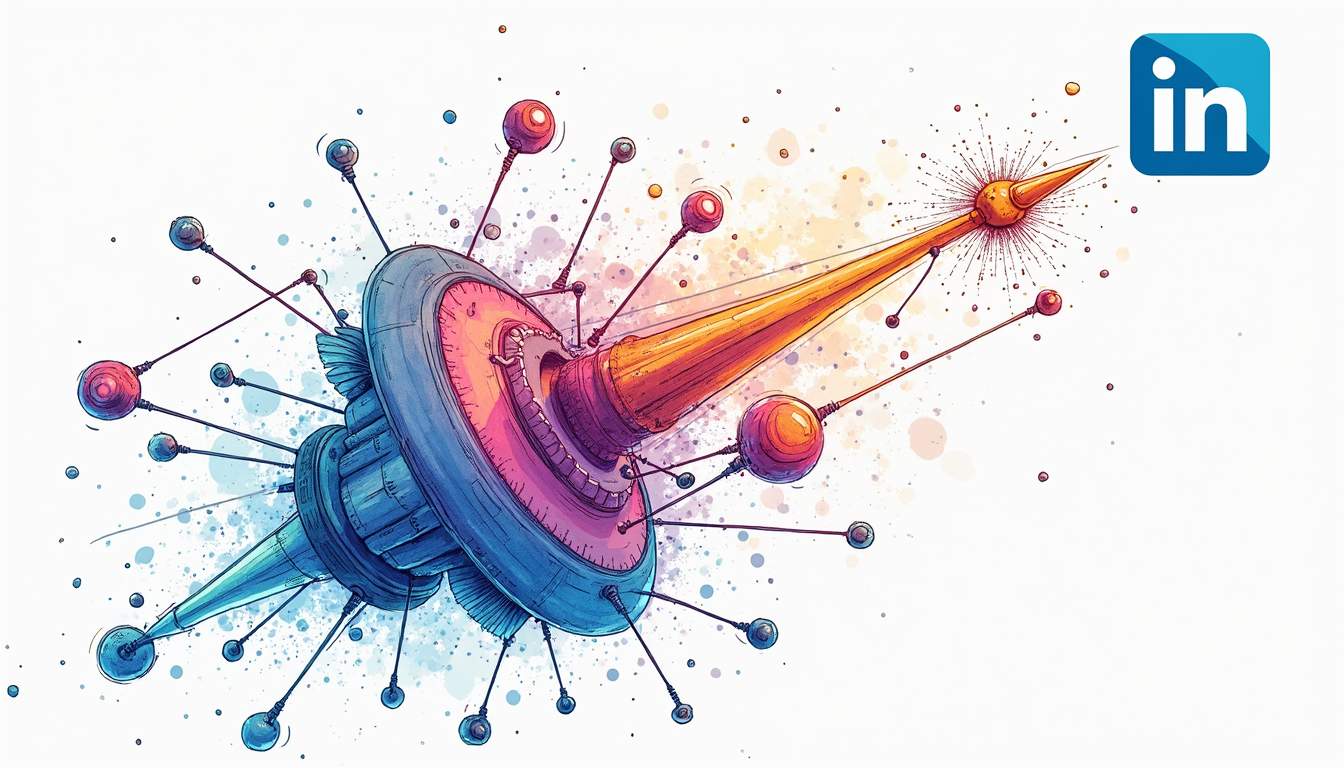Advertising solutions such as artificial intelligence (AI) and machine learning (ML) on LinkedIn can be a cost-effective means to reach a targeted professional audience. However, understanding the associated costs and strategies is crucial for maximizing your return on investment. In this article, we will delve into the complexities of LinkedIn advertising, including cost factors, advertising strategies, and how to measure success. Let’s explore these topics to help you formulate a clear advertising plan.
Understanding LinkedIn Advertising
Basics of LinkedIn Advertising
LinkedIn advertising allows businesses to promote their products and services to a professional audience. Unlike other social media platforms, LinkedIn is tailored specifically for networking between professionals and businesses, making it unique for B2B advertising.

The advertising process on LinkedIn involves selecting your ad format, setting a budget, targeting a specific audience, and crafting significant ad content. The platform offers various ad formats, including text ads, sponsored content, and InMail, each of which can cater to different marketing goals and audiences. Sponsored content, for instance, allows companies to share articles, videos, or infographics directly in the LinkedIn feed, providing a more organic way to engage users. This format is particularly effective for building brand awareness and establishing thought leadership in your industry.
Importance of Advertising on LinkedIn
Advertising on LinkedIn offers numerous benefits, particularly for companies specializing in AI and machine learning solutions. Firstly, LinkedIn hosts a professional audience that is more likely to engage with B2B offers. Moreover, the ability to utilize advanced targeting filters means that marketers can specifically reach key decision-makers, ensuring that their message resonates with the right audience. For example, advertisers can filter by job title, industry, and even company size, allowing for a highly tailored approach that can significantly increase conversion rates.
Furthermore, LinkedIn allows for enhanced analytics, enabling advertisers to track the performance of their campaigns in real time. This crucial data can drive more informed decisions and optimize advertising strategies consistently. By analyzing metrics such as click-through rates, engagement levels, and demographic insights, businesses can refine their messaging and targeting to better align with their audience’s preferences. Additionally, LinkedIn’s Lead Gen Forms simplify the process of capturing leads directly within the platform, making it easier for potential clients to express interest without navigating away from the ad. This seamless experience not only boosts lead generation but also enhances the overall effectiveness of campaigns.
Cost Factors of LinkedIn Advertising
Ad Format and Its Impact on Cost
The format of your LinkedIn advertisement directly influences the overall cost. Generally, sponsored content and InMail ads tend to be more expensive than text-only ads but often have higher engagement rates.

For example, sponsored posts that include images or videos typically yield better results but come at a higher price. InMail, which directly lands in a user’s inbox, usually commands a premium cost but can significantly enhance engagement due to its placement and format. Furthermore, the visual appeal of rich media ads can lead to increased brand recall and a stronger emotional connection with the audience, making them a worthwhile investment for businesses aiming to create a lasting impression.
Moreover, the choice of ad format can also affect the creative resources required. High-quality videos or striking images may necessitate additional production costs, but they can lead to a higher return on investment (ROI) if executed well. As such, businesses must weigh the upfront costs of creating compelling content against the potential benefits of increased engagement and conversion rates.
Bidding Strategy and Cost
LinkedIn operates on a bidding system where advertisers can either choose cost-per-click (CPC) or cost-per-impression (CPM) strategies. Depending on your campaign objectives—whether your goal is to drive traffic or increase brand visibility—the chosen strategy will affect costs.
For instance, if you opt for CPC, you’ll only pay when someone clicks on your ad. In contrast, with CPM, you pay for every thousand impressions. A carefully considered bidding strategy can help manage costs while still reaching your target audience effectively. Additionally, LinkedIn offers automated bidding options, which can optimize your ad spend by adjusting bids based on real-time competition and performance metrics, allowing advertisers to maximize their budget without constant monitoring.
It’s also important to note that the bidding landscape can fluctuate based on demand and competition for specific audience segments. Advertisers may find that certain times of the year, such as the end of the fiscal quarter or during major industry events, can lead to increased competition and higher costs. Staying informed about these trends can help in planning and executing more cost-effective campaigns.
Target Audience and Geographic Location
The demographic specifics of your target audience significantly affect advertising costs on LinkedIn. By narrowing down your audience based on industry, job title, and location, you may find variations in the cost-per-click for ads. For example, targeting executive roles in tech hubs will often command higher CPC rates compared to generic targeting.
Additionally, geographic targeting plays a role in cost. Ads targeting highly competitive markets, such as Silicon Valley, may come with increased expenses compared to less competitive regions. Therefore, understanding where your ideal customers are located and their respective costs can inform more strategic budgeting decisions. Furthermore, LinkedIn allows advertisers to tailor their messaging based on regional preferences and cultural nuances, which can enhance the effectiveness of ads and potentially justify higher spending in competitive areas.
Moreover, analyzing the performance of ads across different demographics and locations can provide insights into where to allocate budget more effectively. By testing various audience segments and geographic areas, advertisers can identify the most profitable combinations, ensuring that their advertising spend is optimized for the best possible results. This data-driven approach not only helps in managing costs but also in refining future campaigns for even greater impact.
Advertising AI and Machine Learning Solutions
Defining Your AI and Machine Learning Solutions
Your advertising must clearly define what your AI and machine learning solutions are and how they can benefit prospective clients. Whether your offerings include predictive analytics, automation tools, or decision-making software, clarity is essential.

Articulating the unique Selling Proposition (USP) of your products will help create compelling advertisements that attract attention. Focus on the outcomes and improvements that your solutions offer, such as increased efficiency, cost savings, or enhanced data capabilities. In addition, consider providing real-world examples or case studies that illustrate how your solutions have successfully transformed businesses. This not only enhances credibility but also allows potential clients to visualize the practical applications of your offerings.
Crafting the Right Message for Your AI and Machine Learning Solutions
Once the benefits of your offerings are clearly defined, the next step is crafting effective messaging. Your content should address the problems that your target audience faces and how your solutions can mitigate these issues. Understanding the pain points of your audience is crucial; for instance, many businesses struggle with data overload or inefficient processes, and your solutions can be positioned as the answer to these challenges.
Utilize data and testimonials to support your claims, and focus on a narrative that resonates with industry-specific challenges. Visual elements also play a vital role in capturing attention—consider using infographics or videos to explain complex AI solutions succinctly. Additionally, incorporating interactive elements, such as webinars or live demos, can further engage your audience, allowing them to experience the functionality of your solutions firsthand. This interactive approach not only fosters a deeper understanding but also builds trust and rapport with potential clients, encouraging them to explore your offerings further.
Optimizing Your LinkedIn Advertising Budget
Setting a Realistic Advertising Budget
Establishing a realistic advertising budget is crucial for bringing your LinkedIn campaign to fruition. Consider the total costs involved, including creative development, audience targeting, and ongoing management of the campaign.
Starting with a smaller budget can be beneficial to test different strategies and gather data. Based on performance metrics, you can gradually scale your budget, channeling funds towards the most successful ad formats and audience segments.
Monitoring and Adjusting Your Advertising Campaign
Continuous monitoring of your LinkedIn advertising campaigns is essential for success. Use LinkedIn Analytics to track engagement, click-through rates, and conversions. Analyzing this data regularly allows you to identify what works and makes informed adjustments to your strategy.
Adjustments may include reallocating your budget, tweaking ad copy, or refining audience targeting to improve performance. A proactive approach to managing your campaigns can lead to better outcomes and cost-efficiency.
Measuring the Success of Your LinkedIn Advertising
Understanding LinkedIn Analytics
LinkedIn provides advertisers with robust analytics tools that help evaluate the effectiveness of their campaigns. This data includes metrics on reach, engagement rates, and audience demographics, which can lead to insightful conclusions regarding your marketing strategy.
By diving deep into the analytics, you can identify patterns or trends that suggest areas for improvement. For instance, if a specific audience segment shows higher engagement rates, consider increasing your focus and budget on that segment.
Key Performance Indicators for LinkedIn Advertising
Establishing Key Performance Indicators (KPIs) is critical for measuring the success of your LinkedIn advertising efforts. Important KPIs may include conversion rates, cost per lead, and overall return on ad spend.
By tracking these indicators, organizations can assess whether their advertising strategies are aligning with business goals and objectives. This data not only informs future campaigns but helps justify advertising expenses to company stakeholders.
In conclusion, while the costs associated with advertising AI and machine learning solutions on LinkedIn can vary significantly, understanding the factors that affect pricing and constantly monitoring your campaigns can lead to effective strategies and measurable success. Investing time and resources into finely-tuned advertising efforts can yield impressive results for your business.